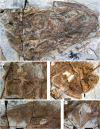A short-armed dromaeosaurid from the Jehol Group of China with implications for early dromaeosaurid evolution
- PMID: 19692406
- PMCID: PMC2842677
- DOI: 10.1098/rspb.2009.1178
A short-armed dromaeosaurid from the Jehol Group of China with implications for early dromaeosaurid evolution
Abstract
Recent discoveries of basal dromaeosaurids from the Early Cretaceous Jiufotang and Yixian formations of Liaoning, China, add significant new information about the transition from non-avian dinosaurs to avians. Here we report on a new dromaeosaurid, Tianyuraptor ostromi gen. et sp. nov., from the Early Cretaceous Yixian Formation of western Liaoning, China, based on a nearly complete skeleton. Tianyuraptor possesses several features only seen in other Liaoning dromaeosaurids, although to a less developed degree, and it also exhibits features unknown in Laurasian dromaeosaurids but present in the Gondwanan dromaeosaurids and basal avialans, thus reducing the morphological gap between these groups. Tianyuraptor possesses a comparatively small furcula and proportionally short forelimbs. This lies in stark contrast to the possible capacity for flight in the microraptorines, which have proportionally long and robust forelimbs and large furculae. The presence of such striking differences between the Early Cretaceous Jehol dromaeosaurids reveals a great diversity in morphology, locomotion and ecology early in dromaeosaurid evolution.
Figures



Similar articles
-
A large, short-armed, winged dromaeosaurid (Dinosauria: Theropoda) from the Early Cretaceous of China and its implications for feather evolution.Sci Rep. 2015 Jul 16;5:11775. doi: 10.1038/srep11775. Sci Rep. 2015. PMID: 26181289 Free PMC article.
-
A basal troodontid from the Early Cretaceous of China.Nature. 2002 Feb 14;415(6873):780-4. doi: 10.1038/415780a. Nature. 2002. PMID: 11845206
-
A new caudipterid from the Lower Cretaceous of China with information on the evolution of the manus of Oviraptorosauria.Sci Rep. 2019 Apr 25;9(1):6431. doi: 10.1038/s41598-019-42547-6. Sci Rep. 2019. PMID: 31024012 Free PMC article.
-
Unenlagiinae revisited: dromaeosaurid theropods from South America.An Acad Bras Cienc. 2011 Mar;83(1):163-95. doi: 10.1590/s0001-37652011000100009. An Acad Bras Cienc. 2011. PMID: 21437380 Review.
-
An exceptionally preserved Lower Cretaceous ecosystem.Nature. 2003 Feb 20;421(6925):807-14. doi: 10.1038/nature01420. Nature. 2003. PMID: 12594504 Review.
Cited by
-
Transformation of the pectoral girdle in pennaraptorans: critical steps in the formation of the modern avian shoulder joint.PeerJ. 2024 Feb 29;12:e16960. doi: 10.7717/peerj.16960. eCollection 2024. PeerJ. 2024. PMID: 38436017 Free PMC article.
-
A new avialan theropod from an emerging Jurassic terrestrial fauna.Nature. 2023 Sep;621(7978):336-343. doi: 10.1038/s41586-023-06513-7. Epub 2023 Sep 6. Nature. 2023. PMID: 37674081
-
Differential locomotor and predatory strategies of Gondwanan and derived Laurasian dromaeosaurids (Dinosauria, Theropoda, Paraves): Inferences from morphometric and comparative anatomical studies.J Anat. 2020 May;236(5):772-797. doi: 10.1111/joa.13153. Epub 2020 Feb 5. J Anat. 2020. PMID: 32023660 Free PMC article.
-
A new paravian dinosaur from the Late Jurassic of North America supports a late acquisition of avian flight.PeerJ. 2019 Jul 10;7:e7247. doi: 10.7717/peerj.7247. eCollection 2019. PeerJ. 2019. PMID: 31333906 Free PMC article.
-
Postcranial skeletal anatomy of the holotype and referred specimens of Buitreraptor gonzalezorum Makovicky, Apesteguía and Agnolín 2005 (Theropoda, Dromaeosauridae), from the Late Cretaceous of Patagonia.PeerJ. 2018 Mar 26;6:e4558. doi: 10.7717/peerj.4558. eCollection 2018. PeerJ. 2018. PMID: 29607264 Free PMC article.
References
-
- Barsbold R., Osmolska H.1999The skull of Velociraptor (Theropoda) from the late Cretaceous of Mongolia. Acta Palaeontol. Pol. 44, 189–219
-
- Burnham D. A.2004New information on Bambiraptor feinbergi (Theropoda: Dromaeosauridae) from the Late Cretaceous of Montana. In Feathered dragons (eds Currie P. J., Koppelhaus E. B., Shugar M. A., Wright J. L.), pp. 67–111 Bloomington, IN: Indiana University Press
-
- Burton D., Greenhalgh B. W., Britt B. B., Kowallis B. J., Elliott W. S., Barrick R.2006New radiometric ages from the Cedar Mountain Formation, Utah and the Cloverly Formation, Wyoming: implications for contained dinosaur faunas. Geol. Soc. Am. Abstr. Prog. 38, 52
-
- Chatterjee S., Templin R. J.2007Biplane wing planform and flight performance of the feathered dinosaur Microraptor gui. Proc. Natl Acad. Sci. USA 104, 1576–1580 (doi:10.1073/pnas.0609975104) - DOI - PMC - PubMed
-
- Currie P. J.1995New information on the anatomy and relationships of Dromaeosaurus albertensis (Dinosauria: Theropoda). J. Vert. Paleontol. 15, 576–591
Publication types
MeSH terms
LinkOut - more resources
Full Text Sources
Miscellaneous

